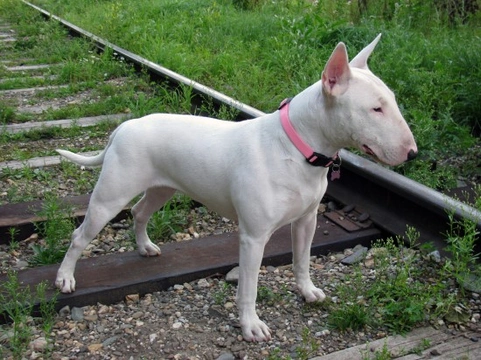
Bull terrier hereditary health and conformation
The Bull terrier is a medium height and very stocky dog breed from the terrier grouping, which has a highly distinctive head, being convex in shape and appearing almost egg-shaped from the front! Dogs of the breed are almost always white in colour, and have very short, straight coats that may occasionally have markings in other colours, or show spotting on the skin through the fine coat. They are rounded and very muscular in build, with stocky shoulders and a very eye-catching jaunty gait.
They stand up to 22” tall at the shoulder, and can weigh up to 38kg, with males generally being larger than females.
Like all pedigree dog breeds, the bull terrier breed as a whole is known to have a propensity to certain hereditary health conditions and potential problems caused by their conformation, and one of the best known of these is a breed predisposition to deafness in around 20% of pure white dogs of the breed. If you are considering buying or adopting a bull terrier, it is of course important to make yourself aware of the potential challenges posed by the breed’s hereditary and genetic make-up, and to research these prior to going ahead. In this article, we will look at the longevity, hereditary health and conformation of the bull terrier in more detail. Read on to learn more.
Bull terrier longevity
Within the UK, the median longevity of surveyed dogs of the breed is 10 years, with the mean being 9 years. However, a reasonable amount of dogs of the breed live for over ten years, with some reaching as old as 15. The average figures for the breed places the bull terrier towards the bottom of the rankings in terms of lifespan across the board for pedigree dogs of a similar size.
Issues with the bull terrier’s conformation
The shape of the bull terrier’s head is one that has been achieved through selective breeding, and is one that does not occur naturally. Ultra typing and over typing, which means breeding to exaggerate this trait further, is discouraged within the breed, and it is wise to choose a dog that does not have an overly exaggerated egg-shaped head.
Inversion of the canine teeth can also occur within the breed, due to the shape of the head and muzzle.
Genetic diversity and breed-specific health testing
The coefficient of inbreeding statistic across the breed as a whole is 14.8%, which is relatively high and considered to be high enough to potentially be problematic across the breed. Potential bull terrier breeders should strive to reduce the coefficient of inbreeding figure within their own breed lines.
The British Veterinary Association recommends hip score testing for parent dogs, due to a breed propensity to hip dysplasia. However, as the breed is not one for which owners regularly undertake hip score testing, no definitive ranking of the hip scores across the breed as a whole has been ascertained.
Testing for primary lens luxation is recommended for miniature bull terriers, but this condition is not considered prevalent within the full-sized version of the breed.
Other tests and databases that are held for the bull terrier in order to improve the health of the breed as a whole include testing for hereditary deafness using the BAER test, and testing for cardiac health and a propensity to heart problems. Kidney tests to ascertain the urine: creatinine ratio for parent dogs is also advised, with a ratio lower than .3 g/g being considered preferable.
Health issues within the breed as a whole
As well as the conditions mentioned above that are commonly tested for across the breed, the bull terrier is recognised as having a hereditary risk of the following conditions in some dogs:
- Hereditary deafness, which is caused by a genetic anomaly that accompanies the gene that causes an all-white coat. Deafness is more prevalent within the bull terrier breed than most other breeds, and around 20% of white dogs of the breed suffer from deafness.
- Heart murmurs are also common across the breed, and tend to progressively worsen with age, potentially causing heart failure. Aortic stenosis, which narrows the aortic arteries, is also present within the breed and can lead to heart disease.
- Atopic allergies have a high occurrence rate across the breed as a whole, and cause a hypersensitivity to certain allergens, such as pollen. This may lead to intense pruritus of the skin, and may cause the dog to scratch themselves to distraction, opening up the possibility of skin damage and infections.
- Cutaneous benign histiocytoma, which is a type of cancer, is recognised within the breed.
- Luxating patellar, or dislocation of one or both kneecaps is present within the breed, but can usually be corrected with surgery.
- Osteochodrosis of the hocks, leading to abnormalities of the cartilage and joints of the hind legs may occur.
- Dry eye is also present within a significant number of dogs of the breed.
- Neural abnormalities may be present, which lead to partial seizures and unusual behaviour patterns such as obsessive tail chasing, inappropriate fear, or unprovoked aggression in a small number of dogs of the breed.



